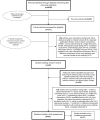Effectiveness of school food environment policies on children's dietary behaviors: A systematic review and meta-analysis
- PMID: 29596440
- PMCID: PMC5875768
- DOI: 10.1371/journal.pone.0194555
Effectiveness of school food environment policies on children's dietary behaviors: A systematic review and meta-analysis
Abstract
Background: School food environment policies may be a critical tool to promote healthy diets in children, yet their effectiveness remains unclear.
Objective: To systematically review and quantify the impact of school food environment policies on dietary habits, adiposity, and metabolic risk in children.
Methods: We systematically searched online databases for randomized or quasi-experimental interventions assessing effects of school food environment policies on children's dietary habits, adiposity, or metabolic risk factors. Data were extracted independently and in duplicate, and pooled using inverse-variance random-effects meta-analysis. Habitual (within+outside school) dietary intakes were the primary outcome. Heterogeneity was explored using meta-regression and subgroup analysis. Funnel plots, Begg's and Egger's test evaluated potential publication bias.
Results: From 6,636 abstracts, 91 interventions (55 in US/Canada, 36 in Europe/New Zealand) were included, on direct provision of healthful foods/beverages (N = 39 studies), competitive food/beverage standards (N = 29), and school meal standards (N = 39) (some interventions assessed multiple policies). Direct provision policies, which largely targeted fruits and vegetables, increased consumption of fruits by 0.27 servings/d (n = 15 estimates (95%CI: 0.17, 0.36)) and combined fruits and vegetables by 0.28 servings/d (n = 16 (0.17, 0.40)); with a slight impact on vegetables (n = 11; 0.04 (0.01, 0.08)), and no effects on total calories (n = 6; -56 kcal/d (-174, 62)). In interventions targeting water, habitual intake was unchanged (n = 3; 0.33 glasses/d (-0.27, 0.93)). Competitive food/beverage standards reduced sugar-sweetened beverage intake by 0.18 servings/d (n = 3 (-0.31, -0.05)); and unhealthy snacks by 0.17 servings/d (n = 2 (-0.22, -0.13)), without effects on total calories (n = 5; -79 kcal/d (-179, 21)). School meal standards (mainly lunch) increased fruit intake (n = 2; 0.76 servings/d (0.37, 1.16)) and reduced total fat (-1.49%energy; n = 6 (-2.42, -0.57)), saturated fat (n = 4; -0.93%energy (-1.15, -0.70)) and sodium (n = 4; -170 mg/d (-242, -98)); but not total calories (n = 8; -38 kcal/d (-137, 62)). In 17 studies evaluating adiposity, significant decreases were generally not identified; few studies assessed metabolic factors (blood lipids/glucose/pressure), with mixed findings. Significant sources of heterogeneity or publication bias were not identified.
Conclusions: Specific school food environment policies can improve targeted dietary behaviors; effects on adiposity and metabolic risk require further investigation. These findings inform ongoing policy discussions and debates on best practices to improve childhood dietary habits and health.
Conflict of interest statement
Figures




References
-
- Writing Group M, Mozaffarian D, Benjamin EJ, Go AS, Arnett DK, et al. (2016) Executive Summary: Heart Disease and Stroke Statistics—2016 Update: A Report From the American Heart Association. Circulation 133: 447–454. doi: 10.1161/CIR.0000000000000366 - DOI - PubMed
-
- Craigie AM, Lake AA, Kelly SA, Adamson AJ, Mathers JC (2011) Tracking of obesity-related behaviours from childhood to adulthood: A systematic review. Maturitas 70: 266–284. doi: 10.1016/j.maturitas.2011.08.005 - DOI - PubMed
-
- Simmonds M, Llewellyn A, Owen CG, Woolacott N (2016) Predicting adult obesity from childhood obesity: a systematic review and meta-analysis. Obes Rev 17: 95–107. doi: 10.1111/obr.12334 - DOI - PubMed
-
- Birch LL (1998) Development of food acceptance patterns in the first years of life. Proc Nutr Soc 57: 617–624. - PubMed
Publication types
MeSH terms
Grants and funding
LinkOut - more resources
Full Text Sources
Other Literature Sources
Medical

